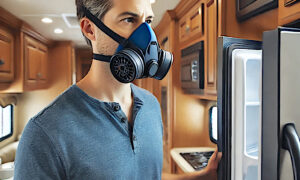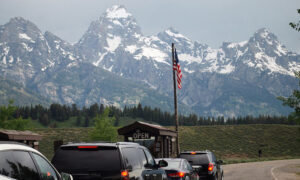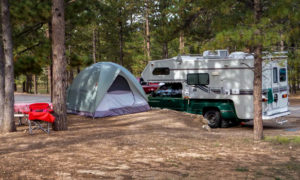
Many tire shops are now filling tires with nitrogen, or at least offering it as an option for an additional fee. Proponents of nitrogen say: “Oxygen in compressed air permeates through the wall of the tire, thus reducing the tire’s inflation pressure. During it’s journey through the tire wall, oxygen oxidizes the rubber compounds in the tire, causing under-inflation and deterioration of the rubber. Dry nitrogen will maintain proper inflation pressure and will prevent auto-ignition, will not corrode rims, extends valve core life, and will help the tire to run cooler.”
I think that’s a lot of hype. And here’s why I say save your money:
Manufacturers add anti-oxidizing agents into the rubber compounds when making tires.
Any RVer who regularly checks his RV’s tire air shouldn’t need to worry about the air leaking out too fast.
The biggest cause of normal tire aging is external… UV-rays and ozone. What’s a little oxygen permeation compared to the aging done to the outside by the environment. Look inside an old tire… it will no doubt look nearly new except for a little dirt.
Here’s my last argument: Dry air contains roughly (by volume) 78.08% nitrogen and 20.95% oxygen. So just how much advantage could there be in a filling a tire with 100% nitrogen over just using air? I’m thinking not much, and certainly not enough to be worth paying extra.
——————-
I Have A Convection Oven in My RV. Now What?
You hate your convection oven because all those recipes that have served you well over the years don’t work in a convection oven. Don’t worry. This 80-page eBook by full-time RVer Adrienne Kristine will help you convert your existing recipes to create the same delicious meals you’ve prepared in the past. You’ll have dozens of new recipes to try, including recipes for potluck dishes to share with six to 10 or more.
All recipes in this eBook are simple and easy with ingredients, cookware and bakeware already found in most RV kitchens. Your convection oven requires less time, less work and gives you better results. What’s not to like? Published 2007. 80 pages.
For more info and to order…Click Here!
—————————-







I would disagree. In the first place, most tire stores that have nitrogen add the Nitrogen at no extra charge. I first used Nitrogen in a set of tires four years ago and got a good 20% more life out of them that I expected. That was on a car. (I bought the tires at Costco and they use Nitrogen exclusively.) I next used them on a fiver and found that the tires ran cooler and showed less wear. I think that the two factors at play are that the nitrogen filled tires run cooler and the lack of oxidation. I know the wheels look better inside when the tires come off.
You may have heard of a class of vitamins called Anti-Oxidants. They work by reducing the damage done to the body over time due to natural oxidation. All rust that you see in the world is due to rust. This is true of the inside of the tire as well. Oxygen under pressure oxidizes things faster. This is partially due to the additional heat. Nitrogen also is a much dryer gas that air. The moisture can make up to 5% of the air in a tire and nitrogen eliminates that. If you use air, make sure it is dried with a dehumidifier.
The one big downside to Nitrogen filled tires is that it is hard to find when you are on the road. So, if you see that a tire is five pounds down, your only options are to find a dealer with nitrogen, or add air. Most studies show that for nitrogen to be effective, you must have it at 98% or better. If you add five pounds of air one time you are below that. Then you have to pay to have the tire purged.
I bought new tires for my Monaco last April. They put in Nitrogen without my asking. I had them put on at a trucking company I knew and it was standard for all their trucks. My tires have held their pressure for 10 months. They may be a pound or two down, but that is all. I run them at 105 pounds, which is what the company suggested. The truck company owner, an old friend, told me they were spending 10% less on tires since the change four years ago. When you run a fleet of over 200 trucks, that adds up in a hurry. That savings included the cost of the nitrogen.
In the end, it is mostly opinions. As to cost, the last time I pulled up to a station to get “air”, I had to pay for the use of the air pump. If you buy tires at Costco (they do not install large tires), Goodyear or Firestone stores, you can go back and get nitrogen for free for the life of the tire. This is true at other dealers.
Just my two cents worth.
Always happy to have another opinion, and you make some good points, but I’m a total skeptic so even though I try to keep an open mind, I still think it’s more hype than reality.